Discover how Luton’s community adapts to road closures and infrastructure upgrades, turning short-term disruption into long-term sustainability and resilience. Learn more now!
A Bedford-based security expert has raised concerns over the planned use of facial recognition software by Bedfordshire Police at this weekend's River Festival.
Bedfordshire Police to Use Facial Recognition
Bedfordshire Police have announced that they will be deploying state-of-the-art facial recognition technology for the first time this weekend, with the aim of catching the county’s most wanted offenders and ensuring the public's safety during the Bedford River Festival. However, this decision has been met with criticism from privacy advocates, including Andy Chesterman of Privacy Helper, who has voiced significant concerns over the implications for law-abiding citizens.
The Deployment of Facial Recognition Technology

The Live Facial Recognition (LFR) technology will be operational in and around the River Festival area on Saturday and Sunday, marking its debut use in Bedfordshire. According to Bedfordshire Police, the technology works by comparing faces from a live camera feed against a police-generated watchlist in real-time. This process involves creating a mathematical representation of key facial features, known as a facial biometric template, which is then compared to known faces to identify possible matches.
The police's watchlist includes suspects wanted for criminal offences, individuals with outstanding warrants issued by the courts, and those with court-imposed notification requirements. When a potential match is flagged, an officer will review the image to determine if further action is necessary. Detective Superintendent Aman Dhaliwal emphasised the importance of public safety and described LFR as a tool to fight crime and protect people, especially with more than 250,000 visitors expected at the festival.
Privacy Concerns and Public Reaction
Despite the police's intentions, Andy Chesterman has raised concerns about the uncontrolled use of biometric data. "The use of live facial recognition in public places is always going to be controversial as it involves the use of biometric data (special category personal data) without any restrictions or controls over who is subject to processing (children or adults)," said Chesterman. He argued that if the areas where LFR is deployed are clearly marked and provide reasonable diversions for those wishing to avoid scanning, it would strengthen the case for its use.
Mr. Chesterman also criticised the lack of detail provided by the police about their watchlists. "Are they taking this opportunity to identify 'petty thieves' or those suspected of more serious crimes? A sledgehammer to crack a nut, or a genuine use case?" he questioned. He pointed out that individuals wanted by the police could easily avoid marked areas, potentially rendering the technology ineffective and only scanning innocent families out for a day of enjoyment.
Police Response and Data Security Assurance
In response to these concerns, Bedfordshire Police confirmed that locations where LFR is deployed will be clearly marked. They also explained that images triggering an alert would be deleted immediately after use or within 24 hours, while those not triggering an alert would be automatically deleted and irretrievable. Tests conducted by the National Physics Laboratory have reportedly verified this functionality.
A spokesperson for Bedfordshire Police acknowledged the possibility that wanted individuals might avoid scanned areas but stated, "If this means that individuals posing a risk to others, or who had been intending to engage in criminality are deterred, then the prevention of crime taking place is a good outcome."
Conclusion
As debates over privacy and security continue, Bedfordshire Police remain committed to using LFR at the River Festival, alongside traditional policing methods to safeguard the event. For more information, the public can visit the Bedfordshire Police's official website or email any concerns to [email protected]. The success or pitfalls of this deployment may set the stage for future uses of advanced technology in public safety measures.